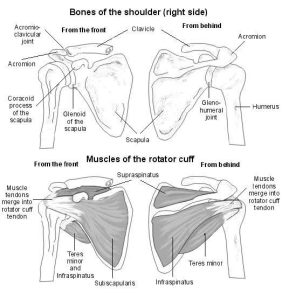When strength training, it happens. That twinge in the soft tissue, that pop of the ligature, that pitch fork stab in the muscle. “I’m okay” you tell yourself, then the pain, the inflammation and the aching begins to disrupt your recreation, work and further workouts. What are you to do?
Say you or a client have shoulder pain. It affects lifting, sparring and day-to-day activity. Now what? You need the inner stamina to know that the body can correct injury provided you understand what to do. View the diagrams below. Where is the pain? You may be fooled because pain can be referred, meaning the point of origin of the pain is not where the pain is felt. For example, the muscle tendons merge into the rotator cuff tendon and if inflamed can radiate pain into the bicep.

Where is your shoulder pain?
Is it in the glenoid of the scapula, the coracoid process of the scapula, the acromio-clavicular joint, one of the four muscles comprising the rotator cuff (supraspinatus, infraspinatus, subcapularis or teres minor)?
There may be no obvious reason for your shoulder pain. The symptoms of rotator cuff disorder include pain that comes on suddenly. The cause of the pain to the rotator cuff includes tears, subacromial impingement, calcific tendonitis. Damaged subacromial space leads to tears and weakness in the shoulder. A tear can be viewed on an ultrasound or MRI but not on an x-ray.
Who is at Risk?
Power lifters are particularly prone to shoulder injury. Why? Because the heavier weights place pressure on the ball/socket joint of the shoulder. Injury to the rotator cuff causes the head of the humeral bone to not be pushed down under the acromion properly. Impingement follows, causing pain. The acromion can have bone spurs or be arthritic, causing pain. Another cause of impingement is from calcific tendonitis affecting the working of the rotator cuff.
A Shoulder Stretch
The trainer may demonstrate this stretch by standing tall, hands clasped behind their back, palms of the hands facing up with fingers interlocked, then, pushing the hands toward the floor which expands the shoulder and opens that ball/socket so there is no impingement at the point of the acromion.
Using Ice and Heat for Shoulder Injuries
When injury occurs you often see athletes with bags of ice on their shoulders. The ice will reduce inflammation, swelling and pain. However, this doctor is not a proponent of continuous cold therapy, i.e. 20 minutes at a time. Rather, my suggestion is alternating heat and cold, meaning one minute as hot as you can stand it and one minute as cold as you can stand it.
Alternate hot/cold alternating 1 minute at a time for 7 cycles totaling 14 minutes. This allows movement of the blood, releasing the stagnant blood carrying inflammatory toxins away from the area, Reducing inflammation/swelling is critical, which can be accomplished naturally by rubbing magnesium oil on the injured area, placing arnica salve on the injured area, as well as taking anti-inflammatory herbs like turmeric and ginger. Further, the inflammation is reduced by eliminating all processed foods, simple sugars and foods that lead to acidity in the body.
One word of caution. You must have a professional determine if cervical or thoracic vertebrate is the origin of your shoulder pain. For example, herniated disks can be the origin to shoulder pain and/or scapula pain from thoracic vertebrate injury. This will require neck and or thoracic MRI.
My first recommendation is hot/cold therapy and inflammation reduction, provided there is absence of thoracic/cervical subluxation and/or herniated disks.
Physiotherapists recommend:
1. Painkillers
2. Anti-inflammatory painkillers. [Dr Dave’s caution: use of anti-anxiety drugs with anti-inflammatories will cause and/or exacerbate depression. Also NSAIDS are known to lead to microscopic tears in the intestines causing undigested food particles to enter the blood stream, leading to circulating immune compounds, causing autoimmune reactions.]1
3. Ice packs
4. Physiotherapy, leading to specific exercises to strengthen the shoulder.
5. Steroid injections. This is to reduce the inflammation in the subacromial space.
6. Surgery for subacromial impingement known as arthroscopic subacromial decompression, which increases the amount of space between the acromion and the rotator cuff. There is also ultrasound barbotage for calcific tendonitis, involving the injection of the calcium deposit with salt water and sucking it out through syringe.
Summary
As a trainer, holistic practitioner, physiologist I have a protocol that I have always engrained in the individuals I have trained, i.e. with proper supervision you can work through the pain and envision that your recovery will occur. An athlete never quits. They only get better. Therefore in summary: (1) have a professional determine the origin of your pain, (2) if needed that determination can be made by having a MRI, (3) reduce inflammation, swelling and pain through hot/cold therapy, decompression of the vertebrate (I like inversion tables), (4) herbs that reduce inflammation; and, (5) supportive exercises rebuilding the musculature so they do not atrophy during recovery.
References
1 Grisanti R. Leaky Gut: Can This Be Destroying Your Health? Functional Medicine University. Online Continuing Education for Functional Medicine. 2016
Dr. Brancato’s cumulative experience in nutrition, alternative medicine, chemistry, toxicology, physiology directed him to holistic approaches in human physiology to correct system imbalances. He maintains his professional certifications as a Naturopath from the American Naturopathic Medical Certification and Accreditation Board; the National Federation of Professional Trainers; Black belts in Kick Boxing and Kenpo.


